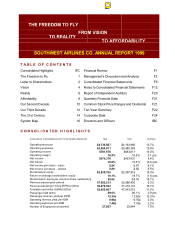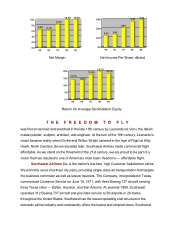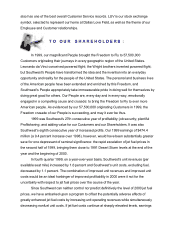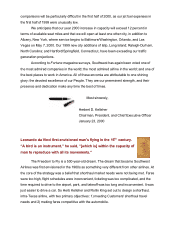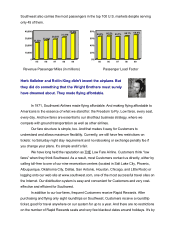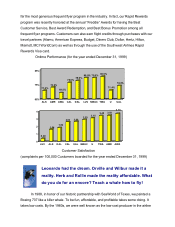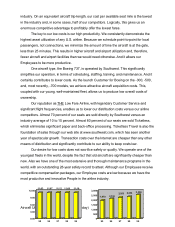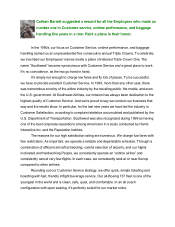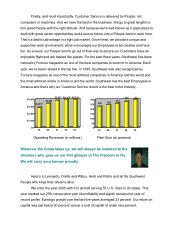Southwest Airlines 1999 Annual Report Download - page 4
Download and view the complete annual report
Please find page 4 of the 1999 Southwest Airlines annual report below. You can navigate through the pages in the report by either clicking on the pages listed below, or by using the keyword search tool below to find specific information within the annual report.
comparisons will be particularly difficult in the first half of 2000, as our jet fuel expenses in
the first half of 1999 were unusually low.
We anticipate that our year 2000 increase in capacity will exceed 12 percent in
terms of available seat miles and that we will open at least one other city, in addition to
Albany, New York, where service begins to Baltimore/Washington, Orlando, and Las
Vegas on May 7, 2000. Our 1999 new city additions of Islip, Long Island; Raleigh-Durham,
North Carolina; and Hartford/Springfield, Connecticut, have been exceeding our traffic
generation projections.
According to Fortune magazine surveys, Southwest has again been voted one of
the most admired companies in the world; the most admired airline in the world; and one of
the best places to work in America. All of these encomia are attributable to one shining
glory: the devoted excellence of our People. They are our preeminent strength, and their
presence and dedication make any time the best of times.
Most sincerely,
Herbert D. Kelleher
Chairman, President, and Chief Executive Officer
January 23, 2000
Leonardo da Vinci first envisioned man’s flying in the 15th century.
“A bird is an instrument,” he said, “[which is] within the capacity of
man to reproduce with all its movements.”
The Freedom to Fly is a 500-year-old dream. The dream that became Southwest
Airlines was first envisioned in the 1960s as something very different from other airlines. At
the core of the strategy was a belief that shorthaul market needs were not being met. Fares
were too high, flight schedules were inconvenient, ticketing was too complicated, and the
time required to drive to the airport, park, and takeoff was too long and inconvenient. It was
just easier to drive a car. So Herb Kelleher and Rollin King set out to design a shorthaul,
intra-Texas airline, with two primary objectives: 1) meeting Customers’ shorthaul travel
needs and 2) making fares competitive with the automobile.

